You've finished a beginner-level textbook like Genki, learned a handful of grammar structures and vocabulary items, and are now ready to put your Japanese into practice! But what many Japanese learners discover next is that Japanese as it's used in common, everyday conversations by native Japanese speakers can be more than a bit different than the sort of Japanese you've gotten used to in a textbook. Of course, the only way to improve in this area is simply through interacting with more native speakers. However, it can be difficult to do this, especially in an environment that fosters learning. This is where HelloTalk comes in.
- What is "HelloTalk"?
- Creating a Profile on HelloTalk
- HelloTalk's Layout and Tools
- A Big-Picture Look at HelloTalk
- Conclusion
What is "HelloTalk"?
HelloTalk is a sort of social network built entirely around the idea of doing language exchanges. Users join HelloTalk equipped with the knowledge they have of their native language, and the desire to learn a new one. With this, users help teach their native language with the hopes that other users will return the favor. While the HelloTalk app provides some tools to aid communication and assist learning, as well as different means to communicate with others and find language partners, how useful this app may be to you is completely dependent on the types of connections you're able to forge and the other user's ability to teach. The app has a variety of users from different countries and supports a number of different languages, but I'll be specifically writing about Japanese and English language exchanges using the Android version of the app in this article.
I've personally had a great experience using HelloTalk, and found it to be a place not only to work on my Japanese and stay motivated, but somewhere I've made real friends. That said, like any social network, it's certainly not without its pitfalls or annoyances. In addition to discussing the app and what it offers, I thought I'd talk about some of my tips for using it, and offer suggestions for how I've gotten the most out of the language exchanges I've had.
Creating a Profile on HelloTalk
When you first join HelloTalk, you're prompted to make a user profile. This process is very familiar to anyone who has made a Facebook account before, however it differs in a few ways. First, you select your native language, as well as your target language, the language you're learning. Next, you select your location. Both of these items can be used to help find your ideal language partners.

Personally, I was most interested in interacting with native Japanese speakers, so I was able to use these features to find people who matched that criteria. But maybe you want to find native speakers nearer to you to help mitigate the time difference. Or you might want to find people who are near you who share your target language to find study partners, as another example. I've also had a handful of Japanese people who had recently moved to Chicago message me to ask for local recommendations! Next, you're given the option to write a self-introduction and pick several interests from a list. For my self-introduction, I wrote briefly about why I had started to study Japanese, as well as about a few of my interests; of course, all in Japanese. This self-introduction, along with the interests you're allowed to select from, can help provide a common ground between you and another person. You can also list out some of the countries you've visited.
When meeting new people on the app, I would always check out their profiles and see if we had anything in common. This is helpful not only for finding things to talk about, but also for constraining the language used to a domain that you can prepare for. Especially when you're first trying to have conversations in a new language, it can be easy to become stuck when you realize you lack either the right vocabulary or a grammar structure to convey what you want to say. But when you have a set topic, it's easy to look up words or grammar ahead of time to help mitigate that barrier. And learning words that pertain to your interests will only give you more means to engage with your interests in your target language in the future.
Finally, you're given the opportunity to add a profile picture. While you don't have to add one, I've found that having one, especially a photo of you, helps with making connections. After all, the goal should be to engage with people, right? There's something nice about being able to see the person you're talking to, rather than an abstract avatar. I think it's important to remember your goal should be connecting with individuals in a mutual and cooperative way, rather than something like the vast anonymity of Twitter, something that I think having a profile picture helps for. It's not essential – in fact, you're able to leave almost every field empty, or omit any details you don't want to share (such as your age or location) – but I felt comfortable with everything asked, and am glad I included the information I did.
Once your profile is all set up, you're ready to go!
HelloTalk's Layout and Tools
Similar to many apps, HelloTalk is divided into different pages, accessed via buttons that run along the bottom of the app. From left to right, they are:
| Talks | A page where you can send and receive direct messages with other users. (called "HelloTalk" on the iOS app) |
| Moments | A timeline feed of posts shared publicly, which is further divided into categories based on the type of post. HelloTalk calls these posts "Moments." |
| Search | A page where you're able to find new language exchange partners based on criteria you enter. |
| Learn | A page where HelloTalk offers small lessons in the form of podcasts, some games, and tutoring. |
| Me | A profile page where you can view and edit your info or your chosen settings. The settings are very standard and minimal; there isn't really anything of note besides the option to back up your chat logs to your account, which is a nice feature if you change phones for some reason. |
As I mentioned earlier, the app is designed primarily around learning through language exchanges with other users, but the app offers a number of different tools to help facilitate this. I'll walk you through each tool in a bit, but the two main ways HelloTalk intends for you to interact with other users are in the chat and posting feature, which HelloTalk calls "Moments."
When you press and hold on either a chat message or a user's Moment, you're given a number of options to interact with it. These are machine translation (similar to Google Translate); corrections, the primary feature, which I'll write more about later; reading, which will play generated audio of the message; transliteration, which will convert Japanese text into romaji, for example; an "AI Grammar" tool that attempts to make grammar suggestions similar to Grammarly; copy, which is pretty self-explanatory; and a favorite button, where you can save texts to review later.
Moments
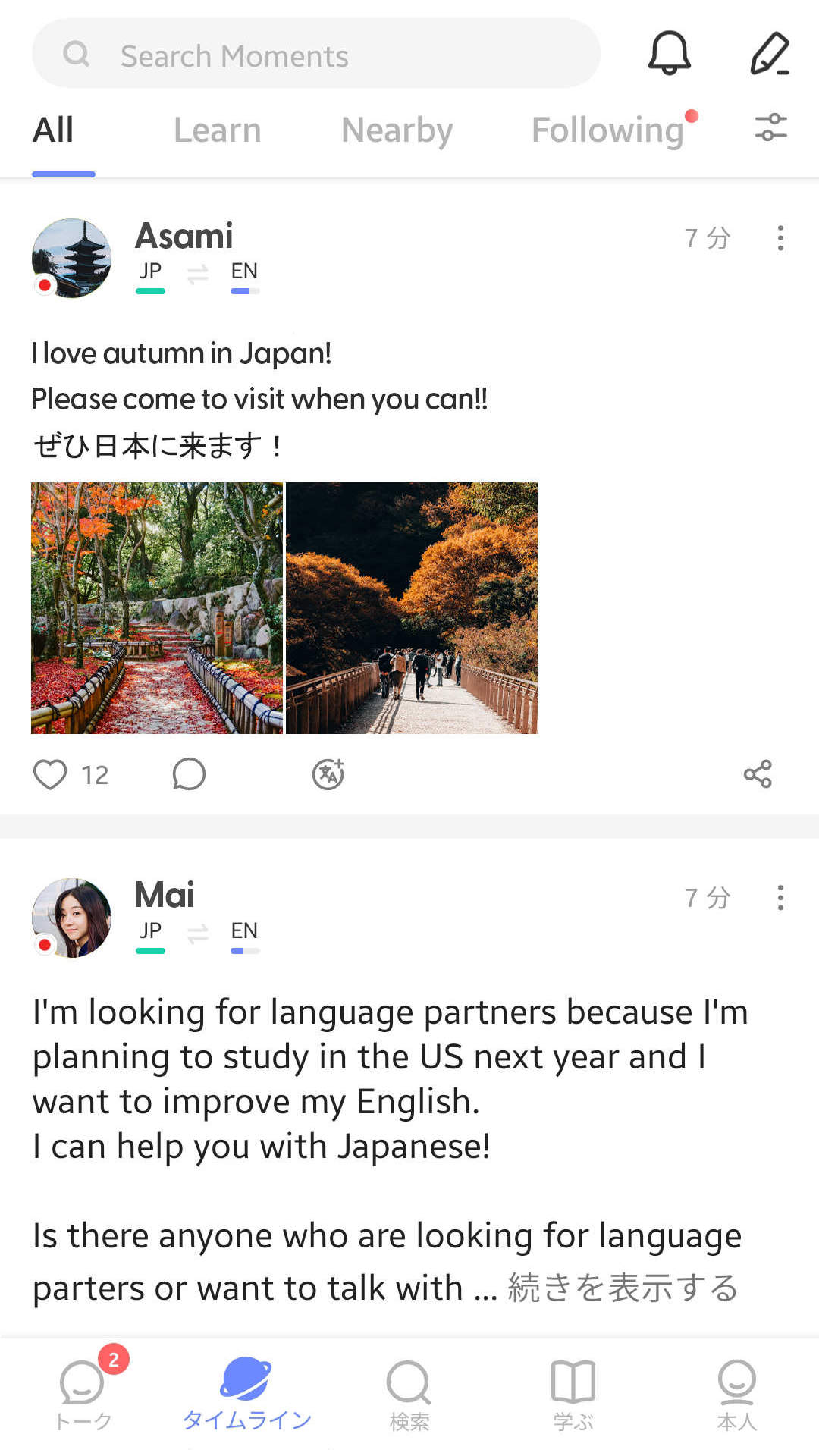
The first button takes you to the messaging page, but first let's talk about one of the best ways to find people to chat with: the second page, "Moments." Moments are HelloTalk's name for posts. Similar to just about any other social network, you can make Moments with a combination of photos, videos, and text. HelloTalk also supports the ability to make audio posts, which is especially helpful to get corrections on your pronunciation. You can also assign a location and topic to a Moment. Topics are like pre-sorted hashtags with a wide variety of themes that users can search for. For example, there are broad categories such as lifestyle, foodie, travel, help me, events, and learning, all with a number of more specific topics underneath those larger umbrellas.
As you might be able to tell from the topics lists, users' Moments fit into a range of different categories, from normal slice-of-life style posts you can find on any social network, to specific questions about grammar or other topics in another language, or broader questions like users asking for corrections. I really appreciate this about HelloTalk; I think it would be quite boring if it was limited only to study help. Instead, by opening it up like other social networks, you can find people talking about any hobby you might have, or ones you're not familiar with yet. I found this to be a really interesting cultural exchange, from people sharing information about their daily lives and interests in Japan, to specific cultural topics I wasn't as familiar with yet, like tea ceremony.
Of course, I wanted to contribute to this as well, and doing so is my first tip! I think it's good to make a number of Moments. For one, it helps show users visiting your profile what you're interested in, beyond just your self-introduction and the interests you've selected. Some users go so far as to say they won't interact with users that don't have Moments in their self-introduction. Frequently making Moments can also help show users you're serious about learning and doing language exchanges, and will be around to help answer questions and chat. But aside from that, it's also a great way to practice writing in your target language, and to share something with other users from another part of the globe.
I often made Moments about my hobbies such as cooking, camping, photography, and running, or whatever Japanese media I was watching at the time. I also made a handful of Moments explaining some English grammar or vocabulary I thought was interesting, or common English mistakes I saw from Japanese users. I was really encouraged by the response to my Moments! I always tried to be very earnest with my interests and enthusiasm for Japanese language and culture in my Moments, and I think that came across to other users. I have had more than a couple different users compliment me on my genuine interest in Japanese culture, like on Moments I made after taking an ikebana course, and with some of my more obscure Japanese cooking Moments. On a few occasions, HelloTalk even featured my Moments, showing them to a wider audience than normal.
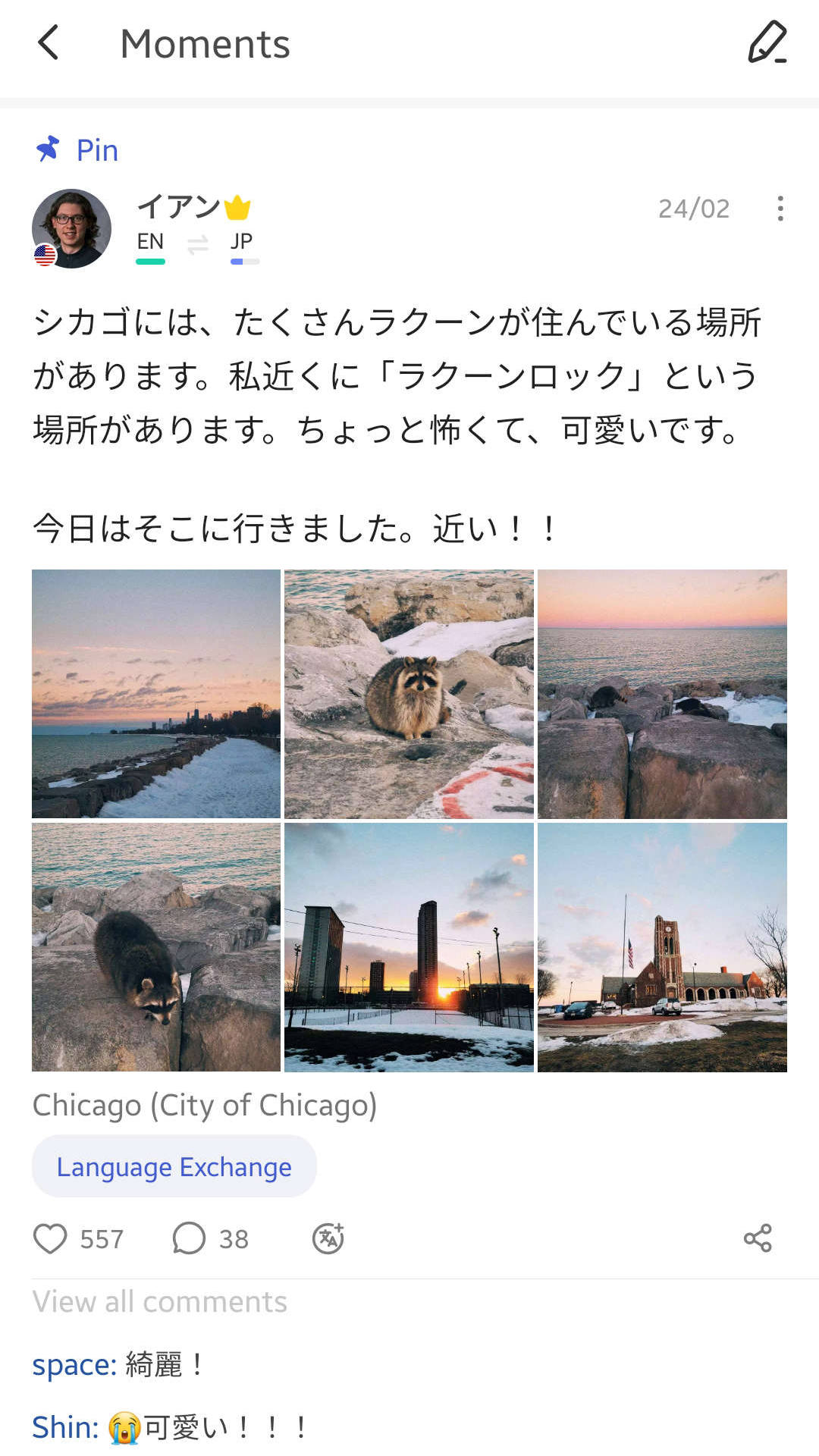
Beyond making your own Moments, browsing the timeline is a great way to interact with other users as well. In the Moments tab, there's a search box to find Moments that correspond to your interest, as well as a number of different tabs that Moments get sorted into automatically, based on topic and content. These categories are All, Learn, Nearby, Following, Help Others, Classmates, and Voice. It's fun to scroll down through "All" Moments and just see the incredible range of topics people post about. Of course, this is a great way to find people who share your interests, who you can then follow. As you might guess, all the Moments from people you follow are collected into the "Following" tab, making it easy to see Moments only from your friends or people you like, similar to many other social networks.
There's also a few different categories with Moments from users asking for help. These range from people asking specific questions either about word choice, word usage, grammar, or the like; to users asking for corrections on journal entries, pronunciation, or more. I liked to scroll through these categories every once and a while and answer questions where I could. HelloTalk filters this to be questions about English from Japanese speakers learning English. I found it really rewarding to do this, in a way that felt like paying forward to all the people who were kind enough to offer corrections on my Moments, or answer questions when I had them.
Moments are a great feature, and with the active user base and tools such as corrections, they're a great place to interact with some native speakers and improve your Japanese. It's also a great place to find people to keep up with, either following them as their Moments come out, or visiting their profile and sending them a message. But even if you're a bit squeamish about instant messaging a stranger directly, through Moments alone anyone can broaden their horizons, interact with a bunch of people around the globe, and improve their Japanese.
Talks
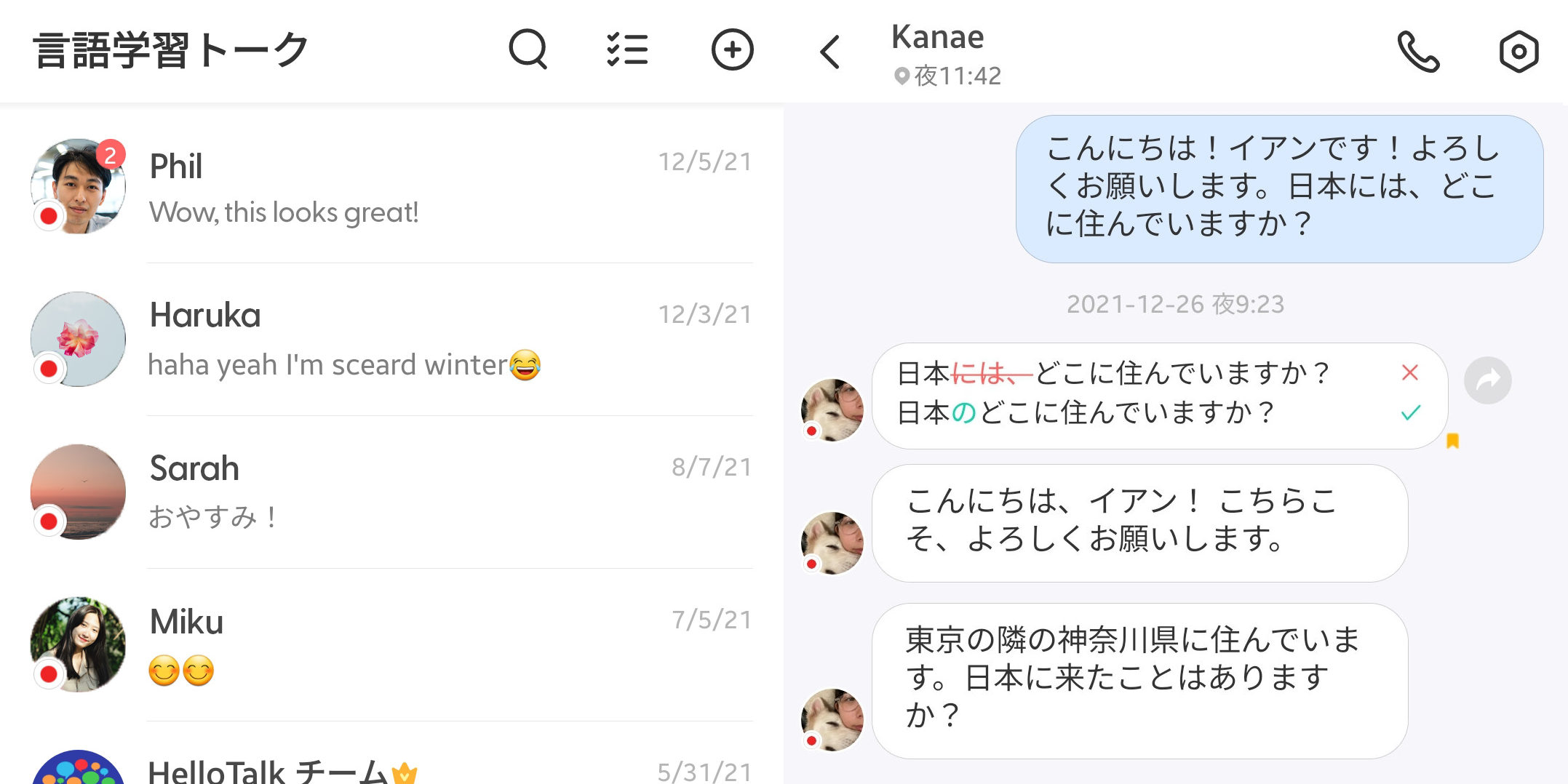
Now that you've interacted with some users on the timeline, maybe you want to message them directly. You can do that on the first page, called "Talks" (on Android), or "HelloTalk" (on iOS). The Talks page contains all the direct messages you have with other users. This works just the same as messaging on other social networks, or through an app like Line or Whatsapp. HelloTalk also supports voice calling and group chats, and I've seen users make posts in the Moments tab about doing language exchange while collectively playing a game like Minecraft, or group study sessions.
The Talks feature is a great way to bridge the gap between simply being "Internet acquaintances," to being genuine friends.
Really, things work as you expect here. I've been lucky enough to make a couple of good friends on HelloTalk, who I've chatted with and done voice calls with for a long time now! I think the Talks feature is a great way to bridge the gap between simply "Internet acquaintances," like someone you follow and see on Moments, and a genuine friend. It's just a lot easier to keep in touch with people and have real conversations with a direct message. Also, once you find someone you feel comfortable with, it can be easier to get specific advice on smaller questions you may not want to make a whole Moment about, or for things like asking for pronunciation help, which you may feel self-conscious about posting publicly.
I think it's really valuable to make friends who are native in your target language. Of course, friends are great for a lot of reasons, but specifically finding people to practice with I found to be a great help. You can support each other's language studies, acting not only as encouragement but help when you have questions or get stuck. You can share interests and aspects of the culture you might not be exposed to otherwise, deepening your interest and understanding in your target language. And having someone you want to keep in touch with is a great way to consistently practice in another language when opportunities might be scarce otherwise.
Search
Aside from finding users to interact with and message on the Moments tab, HelloTalk has a search tab dedicated to finding new language exchange partners. Like the Moments tab, this comes pre-sorted into a few different categories, which are "Serious Learners," Nearby, City, and Gender. There's also an eyeglass button on the top of the page that allows you to set filters and parameters to narrow your search down. Pulling down from the top on the page also refreshes the list with new users.
This can be good if you're looking for a specific type of person. For example, maybe you want to find people local to you, or would prefer to interact only with people your own gender, or near your age. From this page, you can filter some of the users down to match your criteria, and then check their user page for any common interests or to see their Moments.
To be honest, I rarely used this feature. Instead, I preferred to make Moments of my interests, and let people message me if they wanted to chat. But it never hurts to reach out if you find someone who seems like a good fit for you, or to help find people you may be more comfortable with.
Learning
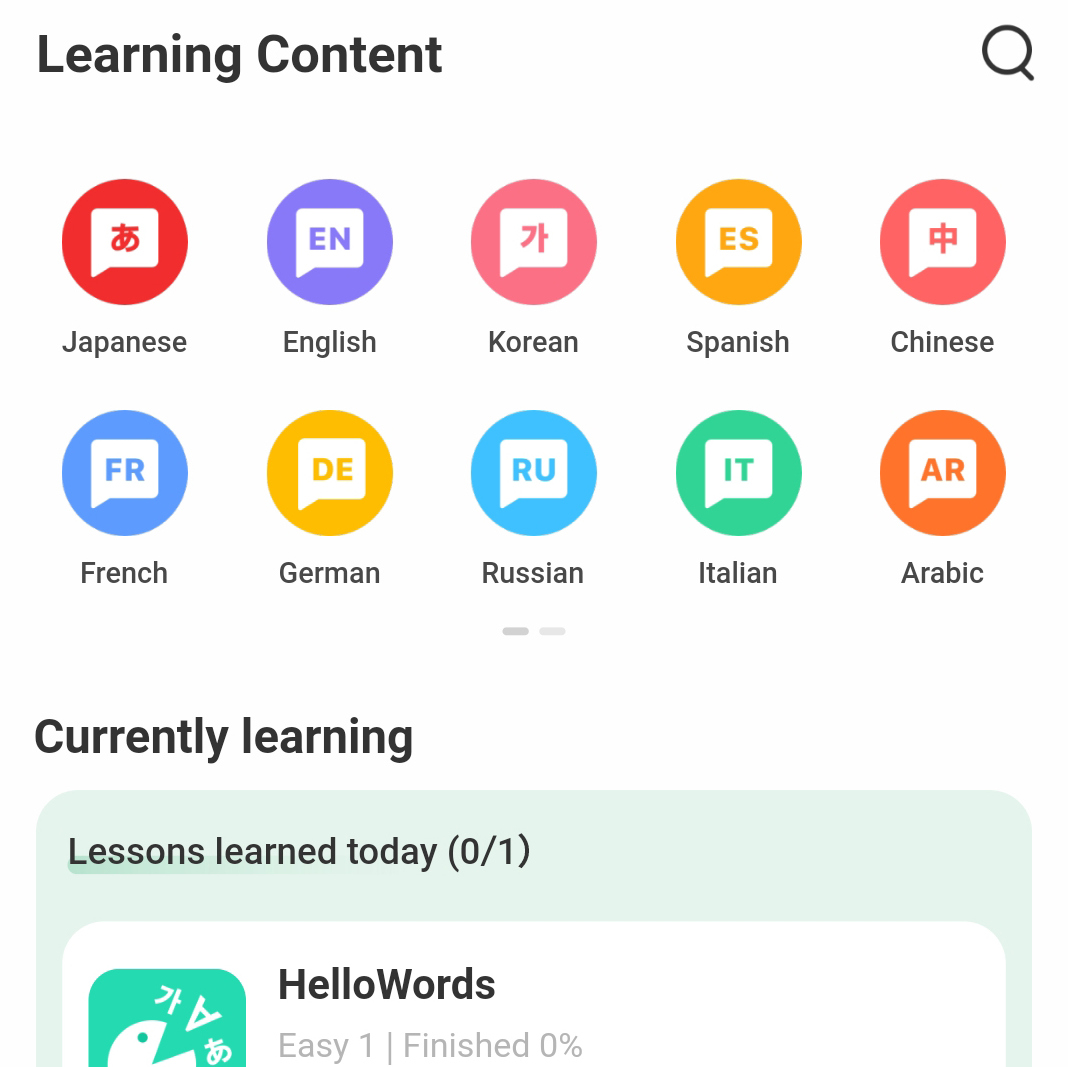
In the Learning tab, you'll find three different means to improve your Japanese. Unlike the rest of the app, this section's content is made by the HelloTalk team, rather than relying on other users to practice together. HelloTalk also has a number of different languages you can take lessons in beyond just English and Japanese, such as Korean, Spanish, Chinese, French, and more. The three learning options available are HelloWords, a game based around learning vocabulary; HelloJapanese, an instructional podcast series similar to JapanesePod 101; and one-on-one online classes with Japanese teachers, similar to iTalki. However, each section requires its own subscription beyond just the trial lessons, which makes all of these learning options very pricey, especially if you wanted to use all three.
HelloWords (Interactive Flashcards for Vocabulary-Building)
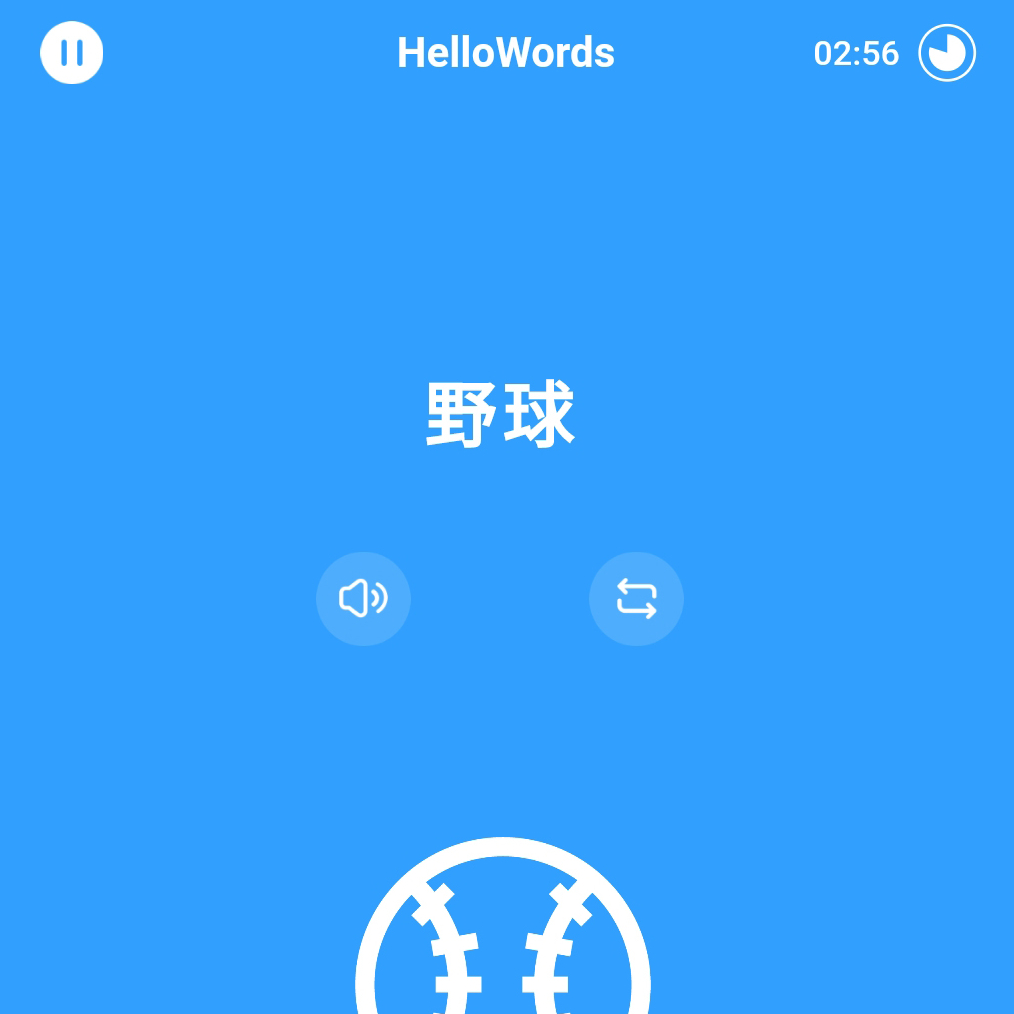
HelloWords is nearly a separate app, all inside HelloTalk. Words are grouped by category, and taught in an interactive flashcard program. There's a huge range of different categories, like "office" or "wild animals," though each category has a condensed list of words, usually around twenty or so. I know how frustrating it is to be trying to express something, only to realize you don't know a word you need, so this is a good option to build up a base of vocabulary, especially in a field you haven't delved into much. With a premium subscription to HelloTalk, you're given limited access to this section. To get unlimited access, you have to purchase a separate subscription, costing $5.50 a month, billed yearly.
HelloJapanese (Podcast Style Lessons)

Similarly, HelloJapanese has built up an impressive library of lessons, going from beginner to intermediate, as well as more specific categories like "Weather" or "Food" or "Business Japanese." The quality of the lessons is high as well, with clear voices and music. It also includes separate pages for the dialogue, vocabulary, and individual sentences covered, which can really help to reinforce what's taught. However, the player certainly leaves something to be desired, featuring only basic play, pause, and scrubbing controls, unlike many other similar apps where speed controls, the ability to jump forward or backward fifteen seconds, and other quality of life improvements are standard. There's a seven-day free trial available for these lessons, but beyond that, access costs $10 a month, billed yearly.
One-on-One Classes
Finally, the classes allow you to take lessons from one of a few Japanese teachers, after doing a 25-minute trial lesson for $10. This seems to be catered towards a few different segments of Japanese learners, from those learning as a hobby, to people who want to work in Japan, or preparing for an exam. It's not a bad pitch, but when trial lessons are available on iTalki for even less, and sometimes free, and with a much wider number of teachers and specializations available, I'm not quite sure the advantage taking lessons through HelloTalk would offer.
A Big-Picture Look at HelloTalk
Now that you've got an idea of HelloTalk's features, I'd like to take a broader look at some of the main benefits for using HelloTalk, as well as some of the shortcomings, both with the app and the community. Finally, I thought I'd offer some tips for getting the most out of the app, and asked a few of the Japanese friends I've made on HelloTalk to give their advice on how to have successful language exchanges.
HelloTalk's Headline Feature: Corrections

Really, the corrections feature is the lifeblood of the app, and the main selling point for using HelloTalk aside from the very active user base. When you press the correction button, you're taken into a new window, where you can suggest edits to something someone has written, in a manner similar to using the "Suggest Edits" feature on Google Drive. You can make changes to some or all of the sentences a user has posted, which HelloTalk will show as a reply in both messages and Moments. The corrections appear in-line, with the deleted or altered words in red with a strikethrough, and the new additions in green. Finally, before you send a correction, you can add a note which gets attached to the corrections. This is usually used as an explanation for what you changed and why, though sometimes users use this space to offer encouragement or comment on the item they're correcting, rather than send two separate messages.

It's a simple system, but an effective one. I've done language exchanges with people on a variety of different platforms, such as Line, Twitter, Skype, and more, and there's really nothing more effective for offering direct notes like this, aside from the very similar features available on Google Drive.
Of course, this sort of correction is far from a comprehensive study approach, but I've found this sort of direct feedback to be extremely helpful. This is especially true in Japanese, which has so many shifting and different forms of the language: from old-fashioned to modern, certain words or phrases that are used almost exclusively in either written or spoken Japanese, varying levels of politeness, regional dialects, and many other similar considerations. There have been times where I've tried to use a word or grammar structure that seemed normal to me in a dictionary or textbook, only to have a native speaker correct me to say it's grammatically correct, but not used in that way, or old-fashioned, or something similar.
This sort of interaction is common when using plain Japanese, like with friends. Many beginner and lower-intermediate textbooks focus on polite Japanese, and with good reason; but there are of course lots of times where you might not want to use polite language. Through HelloTalk, I've been fortunate to interact with a lot of Japanese people my age, and get a better grasp of more informal Japanese as it's really used, all while still in America.
The Community
The other reason to use HelloTalk is of course the community that it's built up over years of operation. I was always impressed by the breadth of users on the app, and the different experiences of culture and language they brought to the table. There're salarymen and housewives, Japanese teachers and regular college students, people from Hokkaido, Okinawa, and every part of the archipelago in-between. It's amazing to be able to connect with such a wide range of people, and to get a glimpse into their daily lives. I've already talked a bit about the expanse of different posts you'll find in Moments, but I want to emphasize what an interesting twist on language learning it is to be able to find people who share a common interest.
It was nice to get to know some people over time as they helped correct my Japanese writing, or to meet users whose knowledge of Japanese I trusted to help answer questions I had.
I found the community to be really eager to help, correcting journal-style posts I made, or answering direct questions I had about Japanese. And likewise, I really enjoyed going through the questions tab on the timeline, and offering advice or giving pronunciation help where I could. Similarly to any social network, you can follow users and users can follow you, which helps to build a rapport between you. It was nice to get to know some people over time as they helped correct my Japanese writing, or to meet users whose knowledge of Japanese I trusted to help answer questions I had.
Finally, I found it to be a really encouraging feeling to be able to interact with native Japanese speakers, get immediate feedback on my writing or pronunciation, and have others tell me they appreciated my posts and photography. It's welcoming in a way that made me want to share more, thereby using Japanese more, and improving all the time. Of course, if you're the sort of person who doesn't really enjoy social media, I'm not sure HelloTalk will change your mind, but I found most everyone to be welcoming, encouraging, and eager to improve together. I felt like the users were mostly my peers in language learning, even if they were trying to learn English, rather than just anonymous people on the Internet.
The Bad
But with all of the good comes some bad, and with HelloTalk, really the biggest benefit is also the biggest downfall, and that's the users. Your experience with the HelloTalk app is entirely dependent on the users you meet and interact with, the types of experiences you're able to have, and how helpful others are. While I feel my Japanese has improved through using HelloTalk, I've also seen my fair share of incorrect corrections and answers to questions, both in English and Japanese. HelloTalk shouldn't be your only source for Japanese information, but it can be a good resource in addition to more traditional ones. I found it's best to take things with a grain of salt, and verify answers you're not sure about through other sources, or with a native speaker you trust.
HelloTalk has been responsive to taking down content that doesn't meet their guidelines, but it's something to keep an eye out for.
Additionally, the user base brings another set of issues, and that's with content and conduct. To be clear, this isn't an issue limited to HelloTalk, and from what I can tell they do a pretty good job of moderating. But at its core, HelloTalk is still a social network. HelloTalk has a list of behaviors they consider unacceptable, such as fraud and fake information, sexual content or using the app for dating purposes, abusive language, religious and political content, and spam, but even with a comprehensive list and good tools for reporting offending content, problems still arise. I've seen a couple of aggressive political posts in the Moments section, and some of the type of misinformation that's become standard in social media. HelloTalk has been responsive to taking down content that doesn't meet their guidelines, but it's something to keep an eye out for.
I know my experience as a cishet white man on the Internet is different from the experience that female-presenting users, minority users, and members of other protected groups have, and HelloTalk is no different. It's not at all uncommon to go to the user page of a woman and to see "No dating / no romance" or something similar listed in their self-introduction, and it's a shame they feel the need to put that. But even scrolling through Moments you'll see strange comments on women's Moments every now and again. HelloTalk is intended to be a community for language learning and cultural exchange, but not everyone is on the same page. Finally, HelloTalk is just a bit clunky as an app, with a handful of strange translations, a few pages that feel disconnected from the rest of the experience, and a subscription process that feels intentionally obtuse at times. Having used the app for over a year, I've seen them make improvements, but it's still got a ways to go.
Tips for Successful Language Exchanges on HelloTalk
"Don't be afraid to make and point out mistakes."
I reached out to two friends I've made on HelloTalk, Haruka and Emi, on tips they had for users, and to share their experiences as Japanese people interacting with English users. Personally, when I was looking for people to interact with, I often looked for active users, who showed a deep interest in improving their English abilities or teaching Japanese. Emi mirrored my thoughts, saying, "I looked for Moments and tried to find serious Japanese learners. I thought serious learners could help each other more than others because they would definitely understand the difficulty of learning other languages."
Both agreed that being proactive is key. "Don't be afraid to make and point out mistakes," Haruka said. "[Don't] hesitate to make mistakes and just try," Emi said. I felt a little uncomfortable at first, sending corrections to people I didn't know, but I reminded myself that I was hoping others would do the same for me. Having the expectation that you are using HelloTalk in an attempt to improve and learn can help ease some of that hesitation.
I tried to balance out the messages I sent in Japanese and English, and not to overdo corrections once I felt comfortable sending them.
Of course, it's a give and take. I tried to balance out the messages I sent in Japanese and English, and not to overdo corrections once I felt comfortable sending them. Of course, the person on the other end of the line is just that: a person. Everyone is different however, and what some users may be looking for is different from some others. Maybe you want to be strictly corrected with every mistake, or maybe it's more encouraging to only gently remind someone of small errors. It's important to know what you'll find most helpful and interact with users who share your aims and preferences, as well as to communicate what you're looking for. Even so, some miscommunications are inevitable. Because of this, I think your mindset and attitude are deeply important. As long as your intentions are good, and you remain earnest, open, and humble, I think most people will be very understanding of cultural differences, or accidentally coming across rudely. Despite being vehemently against them in English, I've taken to using emojis when chatting with Japanese people; the right emoji can go a long way towards indicating the tone of a message, or helping to convey when I was trying to make a joke, which can otherwise get lost in text communication. Just keep in mind that everyone is there to learn and trying their best.
Conclusion
Overall, HelloTalk is offering something rather unique in the language learning space. It features a vibrant community of (mostly) like-minded language learners, with whom you can both learn from and help improve. I'm very thankful for the friends I've made on the app, all the positive interactions I've had, and what people have taught me, but it really is a case of "your mileage may vary." I found HelloTalk to be a really rewarding social network to be a part of, and always looked forward to sharing my experiences with others and improving together, but that's not to say HelloTalk is not without its warts. I can say first hand there's a great experience to be had on HelloTalk, but your own enthusiasm can only bring you halfway.
Ian’s Review
HelloTalk has a vibrant and active community of users, as well as a number of useful tools that make language exchanges both easy and fun. However, it’s not without its flaws, many of which come hand-in-hand with the user-focused system HelloTalk is built around. It can be a great place to meet new people, learn things about Japanese, and improve with others, but the experience you have depends on the other users.
